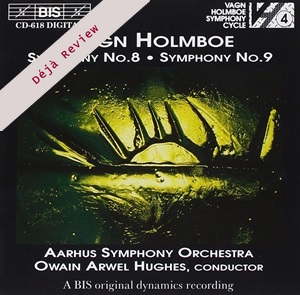
Déjà Review: this review was first published in September 2002 and the recording is still available.
Vagn Holmboe (1909-1996)
Symphony No 8 ‘Sinfonia Boreale’ (1952)
Symphony No 9 (1967-9)
Aarhus Symphony Orchestra/Owain Arwel Hughes
rec. 1993, Musikhuset Aarhus, Aarhus, Denmark
BIS BIS-CD-618 [65]
Vagn Holmboe is a major symphonic composer, and these two symphonies are among his finest creations. Taken from the complete recording by these performers, this disc of Symphonies Nos 8 and 9 in many ways represents an ideal introduction to Holmboe’s orchestral music.
Symphony No 8 has the subtitle ‘Sinfonia Boreale’, indicating its links with Nordic imageries. Written in 1952, it is a strongly structured and purposeful work of some thirty-five minutes’ duration. The four movements adopt clearly balanced and focused identities that have much in common with the traditional four movement layout of the symphony, with a particularly dramatic driving scherzo which is placed second in the sequence. This music makes a strong impression at first hearing, which is why this work is an ideal introduction to Holmboe. But the remaining movements, different though they are, maintain the quality of invention.
Holmboe is an assured orchestrator, but the weight of symphonic line and argument is always his priority, and he never uses the colouring of instrumental combinations to merely engage the ear on a surface level. Rather, everything is in its appropriate place in the scheme of things, just as we might say, for example, of the symphonies of Brahms. Perhaps he also owes a debt to his great Danish predecessor Carl Nielsen in this regard. The symphony is also a strongly cohesive work on the larger scale, across its four movements. Thus the final stages are a genuine culmination, powerful in their integrated logic.
All these observations stem also from the qualities of the performance, and Owain Arwel Hughes proves himself an excellent conductor of this music. The orchestral playing is clear in focus, tight in ensemble, and well characterised, while the BIS sound is as clear and reliable as ever.
These virtues can also be experienced in the Symphony No 9. This followed the Eighth by a distance of some fifteen years, surprising as that may seem for so committed a symphonist. In fact, it took a commission from the Danish Broadcasting Commission to encourage Holmboe to return to symphonic action, and he completed the score in 1969, having revised it after the first performance. The dedication, interestingly, was given to the eminent French musicologist and teacher Nadia Boulanger.
The biggest difference between the two works is that the Ninth has an altogether more sophisticated orchestral palette (which does not make it the better work). There are five closely linked movements, three of them ‘substantially symphonic’, while movements two and four take the form of intermezzos, scored only for strings. Hughes and his orchestra pace the music carefully, and again the results are at once convincing and satisfying.
Terry Barfoot
Buying this recording via a link below generates revenue for MWI and helps us keep free access to the site




















